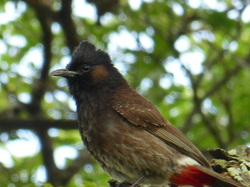The Hawaii Nature Journal
The monarch butterfly, Danaus plexippus, is a familiar backyard visitor and easy to recognize with its bold orange and black patterning. They arrived in the Hawaii islands around 1850, not long after the introduction of the host plants Asclepias curassavica, also known as the tropical milkweed, and later, Calotropis gigantea, the crown flower. Whether they came here on their own, or with the aid of humans is not known. They are capable of great migrations and have crossed the Atlantic, though they never became established in Great Britain, probably due to the absence of their host plants. Host plants are the plants that different butterfly species lay their eggs on and which their larvae eat. They also need nectar plants, which attract and feed the adult butterflies. Monarchs are present in the Pacific islands wherever their host plant exists; however, those in Hawaii don't appear to migrate. The red-vented bulbul is reported to eat monarchs.
The red-vented bulbul is reported to eat monarchs.
Monarchs are poisonous to many potential predators due to the Cardiac glycosides they have from eating the milkweed plants. These substances are strong heart stimulators, and can be fatal to birds. However, the two bulbul species here, the red-vented and the red-whiskered bulbul apparently do eat monarchs. It has also been noted that certain mice are able to eat monarchs. Other predators of adults include wasps. Spiders and ants may attack the eggs, which is the first of the four stages in the complete metamorphosis that the monarch undergoes.
The female lays the eggs on the undersides of the milkweed leaves, and they hatch in three to five days. The larvae, or caterpillars, wriggle out and start feeding on the host plant. They will grow and molt four times, before they attach themselves to a secure spot and molt for a final time. The skin then hardens, and the beautiful green chrysalis forms, protecting it while it undergoes the most amazing transformation of them all. In less than two weeks, the chrysalis becomes clear, and soon after, the adult monarch emerges. The adults lives only for several weeks, feeding on nectar with their straw-like tongue, the proboscis.
The female lays the eggs on the undersides of the milkweed leaves, and they hatch in three to five days. The larvae, or caterpillars, wriggle out and start feeding on the host plant. They will grow and molt four times, before they attach themselves to a secure spot and molt for a final time. The skin then hardens, and the beautiful green chrysalis forms, protecting it while it undergoes the most amazing transformation of them all. In less than two weeks, the chrysalis becomes clear, and soon after, the adult monarch emerges. The adults lives only for several weeks, feeding on nectar with their straw-like tongue, the proboscis.


